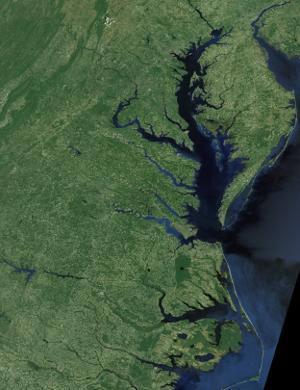Extreme weather events in Chesapeake Bay give clues for future climate impacts

The Chesapeake Bay area, with Baltimore to the north is shown. Image courtesy NASA Goddard Space Flight Center Landsat Data Continuity Mission Education and Public Outreach team (GSFC LDCM EPO). Credit NASA Goddard Space Flight Center Landsat Data Continuity Mission Education and Public Outreach team (GSFC LDCM EPO).
The intensity, duration, and frequency of extreme temperature- and precipitation-based events are key components to understanding the climate of Chesapeake Bay.
Kari Pohl of the Center for Environmental Science at the University of Maryland and colleagues studied these components by calculating 26 extreme climate indices defined by the Expert Team on Climate Change Detection and Indices. She will report their findings at the Annual Meeting of the Geological Society of America on 1 November in Baltimore, Maryland, USA.
“A traditional view of historic climate change is to determine mean annual changes,” Pohl explained. “However, organisms do not feel means; they feel the day-to-day variability and extreme events, such as the frequency of warmer-than-normal days.”
The goals of the project include reconstructing extreme climate changes from the recent past (1894-2014), using historically referenced data to assess near-future global climate model projections, and to ultimately use this analysis to investigate ecological problems in Chesapeake Bay, such as eelgrass diebacks.
The study saw changes that included an overall decrease in cold events, a higher probability to have a year without a cold spell, and an increase in the annual number of wet days.
These extreme climate indices were strongly correlated to the shallow water environment, including streamflow and water temperature. These linkages will allow insights on how extreme changes could affect environmental boundaries and critical threshold events of vulnerable organisms.
Pohl hopes that studies such as this one “will enhance our general understanding of historical and future extreme climate variability, allowing policy-makers to make better-informed decisions for coastal communities.”
###
CONTACT:
Kari Pohl, Center for Environmental Science, University of Maryland
kstlaurent@umces.edu
WHAT:
Session No. 54: Restoring the Nation's Largest Estuary: Lessons Learned from Efforts to Address Changes in Water Quality and Ecosystem Structure and Function within the Context of Landscape Change and Climate Variability in the Chesapeake Bay and Its Watershed
Session hyperlink: https:/
Paper No. 10: Chesapeake Bay Climate Extremes and Variability: a Recent Past, Present, and Near Future Analysis
Abstract hyperlink: https:/
WHEN & WHERE:
Sunday, 1 November 2015: 1:30-5:30 PM
Room 308 (Baltimore Convention Center)
Presentation Time: 3:55 PM
The Geological Society of America, founded in 1888, serves more than 27,000 members from academia, government, and industry in more than 100 countries. Through its meetings, publications, and programs, GSA enhances the professional growth of its members and promotes the geosciences in the service of humankind. GSA encourages cooperative research among earth, life, planetary, and social scientists, fosters public dialogue on geoscience issues, and supports all levels of earth science education.
Media Contact
All latest news from the category: Earth Sciences
Earth Sciences (also referred to as Geosciences), which deals with basic issues surrounding our planet, plays a vital role in the area of energy and raw materials supply.
Earth Sciences comprises subjects such as geology, geography, geological informatics, paleontology, mineralogy, petrography, crystallography, geophysics, geodesy, glaciology, cartography, photogrammetry, meteorology and seismology, early-warning systems, earthquake research and polar research.
Newest articles

Recovering phosphorus from sewage sludge ash
Chemical and heat treatment of sewage sludge can recover phosphorus in a process that could help address the problem of diminishing supplies of phosphorus ores. Valuable supplies of phosphorus could…

Efficient, sustainable and cost-effective hybrid energy storage system for modern power grids
EU project HyFlow: Over three years of research, the consortium of the EU project HyFlow has successfully developed a highly efficient, sustainable, and cost-effective hybrid energy storage system (HESS) that…

After 25 years, researchers uncover genetic cause of rare neurological disease
Some families call it a trial of faith. Others just call it a curse. The progressive neurological disease known as spinocerebellar ataxia 4 (SCA4) is a rare condition, but its…





















